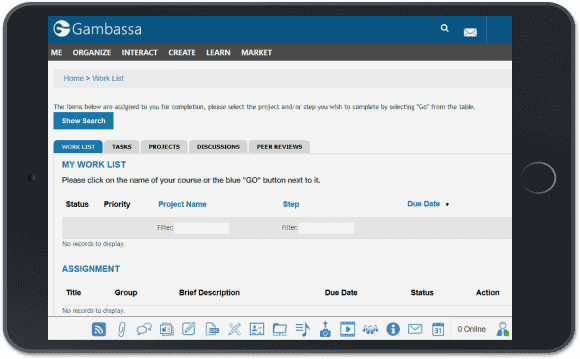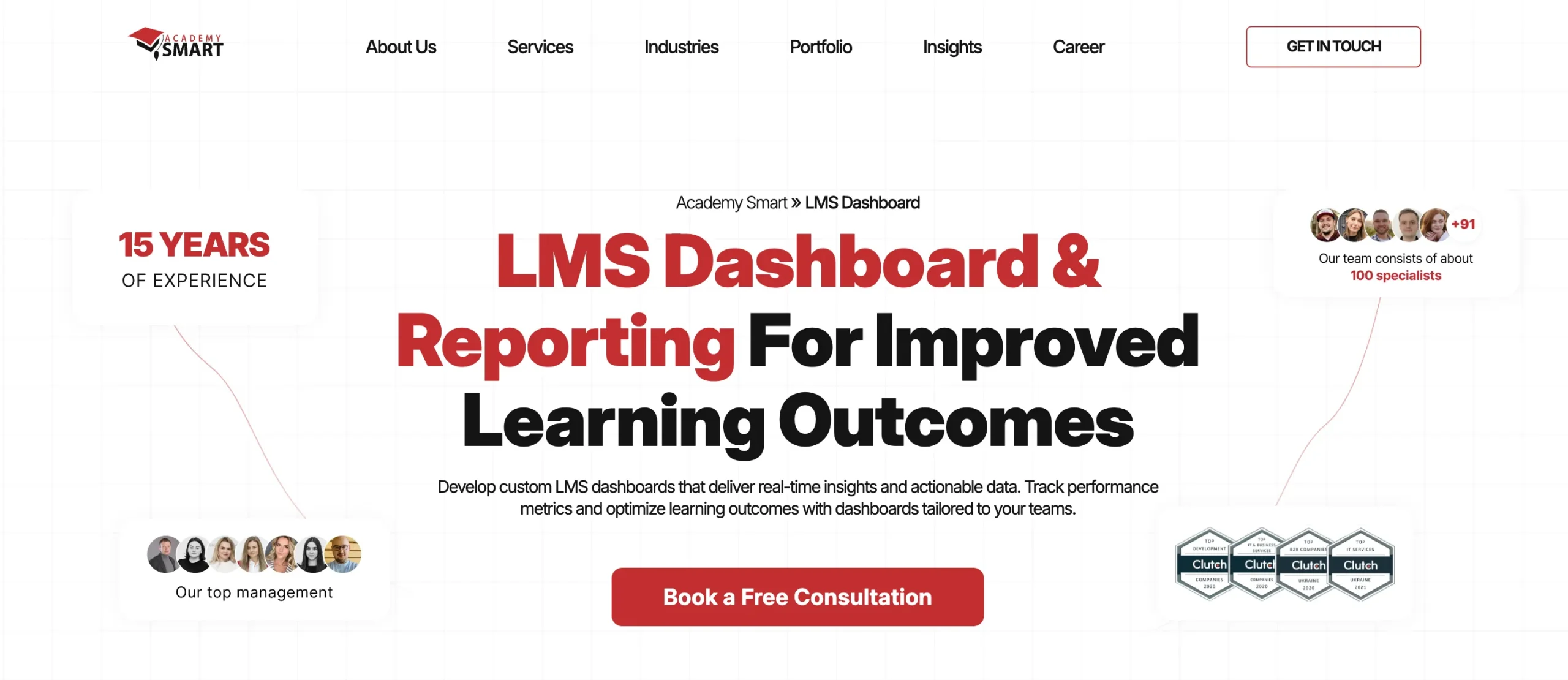
Future-Proofing Your LMS with LTI Integration
Contents
Interoperability challenges and limited educational content access control hinder education platforms’ efficiency. According to the EdTech Top 40 report, students and educators accessed an average of 42 learning tools each during the 2022-2023 school year. Adopting LTI standards offers LMS and content providers enhanced interoperability, customer experience, and monetization opportunities for the platform’s longevity.

With 15+ years of experience, Academy SMART specializes in custom eLearning software development. Offering expertise in LMSs, virtual classrooms, custom apps, and gamification, we seamlessly integrate Learning Tools Interoperability (LTI) for smooth functionality across platforms, catering to the diverse educational needs of LMS and content providers.
In this post, we explore the benefits of LTI integration for education stakeholders, covering the importance of LTI compliance, technical integration details, and real-world use cases. Through our clients’ success stories, discover how LTI integration enhances educational experiences.
Why LTI Compliance Matters
What is LTI integration? Learning tools interoperability (LTI) integrates diverse campus systems into a coherent ecosystem. Developed by the 1EdTech Consortium, LTI allows courseware and learning tools from various vendors to be integrated within a learning platform, such as an LMS. Recent research confirms that these LMS integration standards enhance teaching and learning activities by securely connecting tools and enriching training methods with extra resources.
The current LTI 1.3 version improves authentication security and introduces the 1EdTech Security Framework, while LTI Advantage further enhances security, integrations, and functionalities like deeper linking and assignment services.
LTI compliance ensures:
- Standardized integration between learning applications and environments
- Streamlined navigation and data security
- Secure launching of tools
- Single sign-on (SSO) functionality
- Cross-platform compatibility
- Rigorous testing
How Academy SMART Ensures LTI Compliance
Adhering to LTI standards is fundamental to Academy SMART’s LMS development approach, ensuring seamless integration and interoperability with external learning tools.
- Staying updated on LTI standards: Diligent monitoring of the latest specifications from the 1EdTech Consortium and actively participating in training sessions and conferences, ensuring effective guidance for our clients in building their LMS platforms.
- Comprehensive documentation: Clear and comprehensive documentation, including detailed instructions, API references, code samples, and troubleshooting, facilitates smooth LTI integration for the LMS.
- LTI conformance testing: Ensure LMS adherence to LTI standards by creating test plans, executing test cases, and meticulously reporting any identified bugs or issues.
LTI Compliance Benefits for LMS Providers and Content Creators
Learning tools interoperability compliance efforts yield significant benefits for our clients.
- Enhanced interoperability: Clients can seamlessly integrate diverse learning tools and content from various vendors, promoting flexibility and choice in educational resources.
- Streamlined integration: LTI simplifies adding new learning resources, reducing development time and costs, expanding their educational offerings efficiently.
- Control over access to learning materials: Control over access to learning materials enables subscription sales and access restrictions, increasing monetization.
- Improved user experience: Learners enjoy a consistent experience within the familiar LMS, fostering engagement and better learning outcomes.
Prerequisites for LTI Integration
LTI integration requires some prerequisites for the most effective implementation in custom LMSs and off-the-shelf solutions. Here are the prerequisites to consider.
For Custom LMS: LTI Integration During the LMS Development Stage
Integrating LTI standards during the development phase of a custom LMS is highly advantageous, as it ensures seamless functionality right from the start. By incorporating LTI compatibility into the core architecture of the LMS framework, developers establish a solid foundation for future improvements and updates.
Minimizing the need for later modifications enables thorough testing to ensure compliance and security standards before deployment, saving time and resources.
For Off-the-Shelf LMS: Access to Source Code and External APIs
Off-the-shelf LMS solutions lacking source code access rely on external APIs for seamless LTI integration that enables communication and data exchange with external learning tools. If APIs are available, Academy SMART can integrate LTI standards developing middleware solutions, serving as gateways for educational content that handles authentication, data exchange, and other LTI-specific functions.
Technology Stack for Successful LTI Integration
Choosing the appropriate technologies and programming languages is critical for the success of Learning Tool Interoperability initiatives. Here are the technologies we employ for our clients.
Primary Technologies and Languages
- PHP and Laravel: Laravel, known for robustness and scalability, is ideal for LTI integration, utilizing packages like Packback/Lti-1p3 for seamless LTI 1.3 integration.
- JavaScript and Node.js: Node.js is ideal for server-side LTI tool providers. It efficiently manages asynchronous operations and leverages frameworks like Express.js for streamlined JavaScript-based integrations.
- Python: Django offers a high-level framework for LTI integrations, easing development and simplifying the implementation of LTI tools and consumers with the pylti library.
- Java: Spring Framework offers comprehensive support for LTI standards, while LTI-Library facilitates seamless development of compliant applications.
Other Considerations
- OAuth and OpenID Connect: Robust authentication and authorization mechanisms, especially crucial for LTI 1.3 and LTI Advantage integrations.
- REST APIs and Web Services: RESTful APIs enable seamless communication between the LMS and external LTI tools for smooth integration.
With the right tech, our clients boost LMS interoperability, future-proofing their platforms.
Academy SMART’s Approach to LTI Integration in LMS
With Academy SMART’s decade-long experience in e-learning software development, you get seamless integration of LTI standards that enhances the functionality of your platform.
Step-by-Step LTI Integration
Integrating LTI requires a systematic process to ensure seamless functionality and secure communication with external tools. Here’s our breakdown of the steps at Academy SMART.
1. LMS Architecture Assessment
First, a thorough analysis of the current LMS architecture is required to identify the most suitable integration points for LTI functionality. Technical infrastructure, data flow pathways, and existing security protocols must be considered.
2. LTI Configuration
Then comes configuring the LMS with the necessary LTI security parameters based on the chosen LTI version (1.3 or LTI Advantage). Establishing key elements such as the Launch URL, Consumer Key, and Shared Secret enables secure communication and authorization with external LTI tools. Additional configuration may be required for LTI Advantage implementations to specify resource endpoints and define security settings.
3. LTI Launch Functionality Development
In this step, developing the functionality within the LMS facilitates the launch of external LTI tools. Integrating with the existing authentication mechanisms of the LMS enables the seamless management of user authentication.
Implementing data exchange protocols (e.g., SAML, OAuth) enables the transfer of user information, grades, and other data between the LMS and LTI tools. Our development team ensures strict adherence to the relevant LTI specifications (LTI 1.3 or LTI Advantage) during development.
4. Testing and Deployment
Conducting comprehensive testing verifies the proper communication and functionality between the LMS and external LTI tools. Testing scenarios such as user launches, data exchange, and error handling ensures robust performance. Once testing is successful, LTI integration is deployed onto the live LMS platform for seamless integration and enhanced functionality.
By following our step-by-step approach, clients effectively integrate LTI into their LMS, accessing various learning tools while maintaining a secure and efficient learning environment.
Let’s see how it works in practice.
Case Study: LTI Integration for Gambassa Learning Management System
Our client, Gambassa Learning Management System provider, sought to enhance its project-based LMS by integrating with external educational platforms via LTI standards. With Academy SMART, the client extended the data model and implemented GUI management for external modules. Using standard HTTP handlers and Web API controllers established communication with external platforms.

Additionally, a Web API Outcomes Controller was developed to receive student marks from external systems. This LTI integration enabled Gambassa’s LMS to utilize external educational modules, expanding its service offerings seamlessly.
With a custom LTI provider developed by Academy SMART, Gambassa consolidated its integration capabilities. LTI compliant LMS attracted more users seeking collaborative learning experiences and enhanced brand reputation.
Ace LTI Integration for Your LMS with Academy SMART
Integrating LTI standards is crucial for LMS future-proofing. By adopting LTI, educational platforms can enhance interoperability, improve the user experience, and unlock monetization opportunities. Academy SMART specializes in seamless LTI integration for secure communication between LMS and external tools. Enhance your LMS with LTI standards by leveraging our decadelong e-learning software experience.
FAQ
Book a free consultation

Reach out to start talking today!











